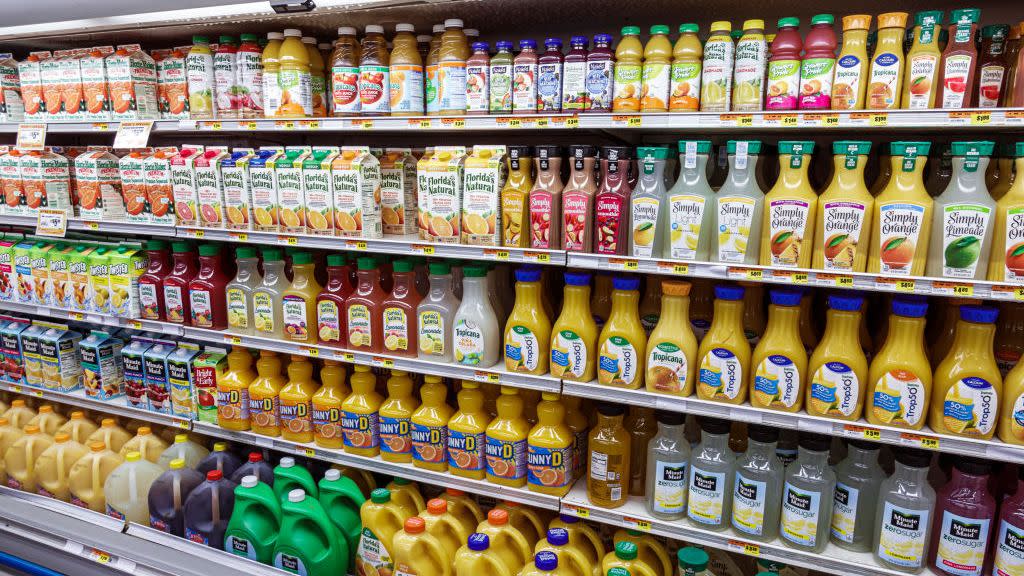PSA: Your Favorite Juice Blends Are Mostly Just Apple

The drinks aisle of your grocery store can be an overwhelming. It feels like the available options has ballooned overnight, and there are countless brands of new-wave sodas, kombuchas, cold brews, and juices on supermarket shelves.
Juice, in particular, has entered something of a renaissance. You can find blends of virtually every kind of fruit these days. The category is expansive, but a lot less diverse than shoppers are being led to believe. This is because most of your fancy fruit juice blends are primarily made with apple juice.
Don’t let the more exciting fruits and “100% Juice” stickers on the label fool you. All you need to do is squint at the fine print and peek at the ingredients list to discover there’s more apple juice in your bottle than anything else.
Your bottled green smoothie? Apple. Your organic cranberry-pomegranate juice in the bougie glass bottle? Apple. Unless your juice specifically states that it’s 100% one particular fruit, odds are that the juices advertised on the bottle only play a supporting role.
But why is that the case? Why use so much apple juice in these blends, and why hide the ingredient within the fine print? There are several reasons why. We’re breaking down the three primary factors that go into the “applejuiceification” of our beverage selections.
Apple Juice Is Cheaper
It primarily comes down to cost. Apple juice is simply cheaper than most other fruit juices. The British Soft Drink Association released a statement confirming that it’s “common practice and has been for several decades.”
Apples are abundant and grow across the United States, so juice producers can minimize expensive transportation costs that come with importing them from warmer climates. The U.S. Apple Association estimates that 95% of apples sold in the United States are grown on American soil.
They’re also much hardier than other fruits. It’s common practice for commercially harvested apples to be stored in temperature-controlled atmospheres for months (sometimes even a full year) to retain their taste and texture.
Compare that to the production costs associated with delicate berries and tropical fruits, and the difference is night and day.
Apple Juice Is Sweeter
Every fruit comes with its own unique flavor profile, and apples are reliably sweet. Consumers prefer their juice to veer towards the sweet side—think about how you rarely see 100% cranberry juice on drink menus. Particularly tart fruits need a sweet counterpart to be palatable (like how we turns lemons into lemonade).
Companies supplement their tart juices with sweet apple juice for this purpose. And as an added perk, they can advertise their product with claims like “100% Juice” and “No Sugar Added.”
Apple Juice Is Milder
Certain fruits impart other characteristics that some companies want to keep to a minimum. Take tannins, for instance. The slightly bitter and astringent quality may be enjoyable in certain wines and teas. But juice drinkers can get turned off if tannins are present in noticeably high quantities. Apple juice’s mild, neutral sweetness offers balance to otherwise assertive flavors.
The practice of using apple juice as the base for blends is widespread and has been that way for a long time. It's not necessarily a bad thing, but it does serve as a reminder for shoppers to be more discerning in general.
It's worth looking at labels with a critical eye, especially when examining some of the health claims. For example, some of the nutritional benefits of juice are overstated. Pomegranates and blueberries have antioxidants, sure, but the apple-based blend is not exactly a superfood.
Researchers at Colorado State University say that juicing removes the healthy fiber from fruits along with many of the nutrients that are bound to it. And once they’re diluted with apple juice, the presence of said nutrients is even less prominent. The fiber also helps regulate your body's absorption of sugar. Without it, juice drinkers are more likely to experience a sugar spike and a quick crash.
Juice, whether it’s a blend or not, is not a nutritional replacement for eating whole fruit. We can just accept it for what it is: a sweet treat.
You Might Also Like


